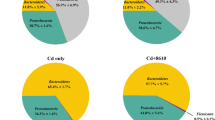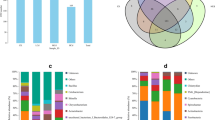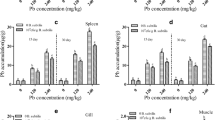Abstract
Cadmium (Cd) poisoning in humans and fish represents a significant global problem. Bacillus cereus (B. cereus) is a widely used probiotic in aquaculture. The objective of this study was to evaluate the potential of B. cereus in ameliorating Cd-induced toxicity in mirror carp. The biosorption rate of Zn for the B. cereus in 85.99% was significantly more than five strains. All fishes were exposed for 30 days to dietary ZnCl2 (30mg/kg), waterborne Cd (1 mg/L), and/or dietary Zn-enriched B. cereus (Zn 30mg/kg and 107cfu/g B. cereus). At 15 and 30 days, the fishes were sampled, and bioaccumulation, antioxidant activity, and intestinal microbiota were measured. Waterborne Cd exposure caused marked alterations in the composition of the microbiota. Dietary supplementation with Zn-enriched B. cereus can reduce the changes in the composition of intestinal microbiota in Cd exposure and decrease the pathogenic bacteria of Flavobacterium and Pseudomonas in Zn-enriched B. cereus groups. The results obtained indicate that Zn-enriched B. cereus can provide a significant protective effect on the toxicity of cadmium by inhibiting alterations in the levels of bioaccumulation and antioxidant enzyme including superoxide dismutase (SOD), catalase (CAT), total antioxidant (T-AOC), and malonaldehyde (MDA). Our results suggest that administration of Zn-enriched B. cereus has the potential to combat Cd toxicity in mirror carp.




Similar content being viewed by others
References
Taweel A, Shuhaimi-Othman M, Ahmad AK (2013) Assessment of heavy metals in tilapia fish (Oreochromis niloticus) from the Langat River and Engineering Lake in Bangi, Malaysia, and evaluation of the health risk from tilapia consumption. Ecotoxicol Environ Saf 93:45–51
Deng G, Li M, Li H, Yin L, Li W (2014) Exposure to cadmium causes declines in growth and photosynthesis in the endangered aquatic fern (Ceratopteris pteridoides). Aquat Bot 112:23–32
Almeida JA, Diniz YS, Marques SFG, Faine LA, Ribas BO, Burneiko RC, Novelli ELB (2002) The use of the oxidative stress responses as biomarkers in Nile tilapia (Oreochromis niloticus) exposed to in vivo cadmium contamination. Environ Int 27:673–679
Heydarnejad MS, Khosravian-Hemamai M, Nematollahi A (2013) Effects of cadmium at sub-lethal concentration on growth and biochemical parameters in rainbow trout (Oncorhynchus mykiss). Ir Vet J 66
Lang Q, Guo Z, Feili Y, Cong Y, Ting Z (2019) Single and combined exposures of waterborne Cu and Cd induced oxidative stress responses and tissue injury in female rare minnow (Gobiocypris rarus). Comp Biochem Physiol Toxicol Pharmacol
Farombi EO, Adelowo OA, Ajimoko YR (2007) Biomarkers of oxidative stress and heavy metal levels as indicators of environmental pollution in African cat fish (Clarias gariepinus) from Nigeria Ogun River. Int J Environ Res Public Health 4:158–165
Thaiss CA, Zmora N, Levy M, Elinav E (2016) The microbiome and innate immunity. Nature 535:65–74
Gómez GD, Balcázar JL (2010) A review on the interactions between gut microbiota and innate immunity of fish. FEMS Immunol Med Microbiol 52:145–154
Larsen AM, Mohammed HH, Arias CR (2014) Characterization of the gut microbiota of three commercially valuable warmwater fish species. J Appl Microbiol 116
Chang X, Li H, Feng J, Chen Y, Nie G, Zhang J (2019) Effects of cadmium exposure on the composition and diversity of the intestinal microbial community of common carp (Cyprinus carpio L.). Ecotoxicol Environ Saf 171:92–98
Wang N, Zhengyao G, Yilin Z, Peijun Z, Jia L, Yi C, Lei Z, Yuehong L (2020) Effect on intestinal microbiota, bioaccumulation, and oxidative stress of Carassius auratus gibelio under waterborne cadmium exposure. Fish Physiol Biochem:1–8
Tian F, Zhai Q, Zhao J, Liu X, Wang G, Zhang H, Zhang H, Chen W (2012) Lactobacillus plantarum CCFM8661 alleviates lead toxicity in mice. Biol Trace Elem Res 150:264–271
Luchese C, Brandão R, Oliveira RD, Nogueira CW, Santos FW (2007) Efficacy of diphenyl diselenide against cerebral and pulmonary damage induced by cadmium in mice. Toxicol Lett 173:181–190
El-Sokkary GH, Awadalla EA (2011) The protective role of vitamin C against cerebral and pulmonary damage induced by cadmium chloride in male adult albino rat. Open Neuroendocrinol J 411:1–8
Pérez Díaz MFF, Acosta M, Mohamed FH, Ferramola ML, Oliveros LB, Gimenez MS (2013) Protective effect of soybeans as protein source in the diet against cadmium-aorta redox and morphological alteration. Toxicol Appl Pharmacol 272:806–815
Chung MJ, Walker PA, Brown RW, Hogstrand C (2005) ZINC-mediated gene expression offers protection against H2O2-induced cytotoxicity. Toxicol Appl Pharmacol 205:225–236
Driessnack MK, Jamwal A, Niyogi S (2017) Effects of chronic waterborne cadmium and zinc interactions on tissue-specific metal accumulation and reproduction in fathead minnow (Pimephales promelas). Ecotoxicol Environ Saf 140:65–75
Khan FR, Mcgeer JC (2013) Zn-stimulated mucus secretion in the rainbow trout (Oncorhynchus mykiss) intestine inhibits Cd accumulation and Cd-induced lipid peroxidation. Aquat Toxicol 142-143:17–25
Banni M, Chouchene L, Said K, Kerkeni A, Messaoudi I (2011) Mechanisms underlying the protective effect of zinc and selenium against cadmium-induced oxidative stress in zebrafish Danio rerio. Biometals 24:981–992
Halttunen, Teemu, Salminen, Seppo, and, Meriluoto, Jussi, Tahvonen (2008) Reversible surface binding of cadmium and lead by lactic acid and bifidobacteria. Int J Food Microbiol
Zhai Q, Wang G, Zhao J, Liu X, Narbad A, Chen YQ, Zhang H, Tian F, Chen W (2014) Protective effects of Lactobacillus plantarum CCFM8610 against chronic cadmium toxicity in mice indicate routes of protection besides intestinal sequestration. Appl Environ Microbiol 80:4063–4071
Lee S, Katya K, Park Y, Won S, Seong M, Hamidoghli A, Bai SC (2017) Comparative evaluation of dietary probiotics Bacillus subtilis WB60 and Lactobacillus plantarum KCTC3928 on the growth performance, immunological parameters, gut morphology and disease resistance in Japanese eel, Anguilla japonica. Fish Shellf Immunol
Yin Y, Zhang P, Yue X, Du X, Li W, Yin Y, Yi C, Li Y (2018) Effect of sub-chronic exposure to lead (Pb) and Bacillus subtilis on Carassius auratus gibelio: bioaccumulation, antioxidant responses and immune responses. Ecotoxicol Environ Saf 161:755–762
Yulin Y, Xinyan Y, Dongming Z, Peijun Z, Abedin A, Yuwei Y, Yanan C, Yuehong L (2019) Study of bioaccumulation, hematological parameters, and antioxidant responses of Carassius auratus gibelio exposed to dietary lead and Bacillus subtilis. Biol Trace Elem Res:1–8
Zhai Q, Yin R, Yu L, Wang G, Tian F, Yu R, Zhao J, Liu X, Chen YQ, Zhang H (2015) Screening of lactic acid bacteria with potential protective effects against cadmium toxicity. Food Control 54:23–30
Wang L, Ge C, Wang J, Dai J, Zhang P, Li Y (2017) Effects of different combinations of Bacillus on immunity and antioxidant activities in common carp. Aquac Int 25:2091–2099
Albert Q, Leleyter L, Lemoine M, Heutte N, Rioult J-P (2018) Comparison of tolerance and biosorption of three trace metals (Cd, Cu, Pb) by the soil fungus Absidia cylindrospora. Chemosphere Environ Toxicol Risk Assess
Hao Wang YJ, Yin C, Deng M, Tang T, Deng B, Ren W, Deng J, Yin Y (2018) Chengquan Tan, Differential analysis of gut microbiota correlated with oxidative stress in sows with high or low litter performance during lactation. Front Microbiol 9:1665
Dai J, Zhang L, Du X, Zhang P, Li W, Guo X, Li Y (2018) Effect of lead on antioxidant ability and immune responses of crucian carp. Biol Trace Elem Res:1–8
Minh ND, Hough RL, Thuy LT, Nyberg Y, Mai LB, Vinh NC, Khai NM, Born I (2012) Assessing dietary exposure to cadmium in a metal recycling community in Vietnam: age and gender aspects. Sci Total Environ 416:164–171
Almeida JA, Novelli ELB, Silva MDP, Júnior RA (2001) Environmental cadmium exposure and metabolic responses of the Nile tilapia, Oreochromis niloticus. Environ Pollut 114:169–175
Wang N, Jiang M, Zhang P, Shu H, Li Y (2019) Amelioration of Cd-induced bioaccumulation, oxidative stress and intestinal microbiota by Bacillus cereus in Carassius auratus gibelio. Chemosphere 245:125613
Jiali X, Fan W, Qi X, Boxing Y, Dongsheng F (2016) Screening of potential probiotic lactic acid bacteria based on gastrointestinal properties and perfluorooctanoate toxicity. Appl Microbiol Biotechnol
Mu D, Meng J, Xiaoxue M, Xiao H, Wang H (2018) The effect of cadmium exposure on diversity of intestinal microbial community of Rana chensinensis tadpoles. Ecotoxicol Environ Saf 154:6–12
Zhai Q, Yu L, Li T, Zhu J, Zhang C, Zhao J, Zhang H, Chen W (2017) Effect of dietary probiotic supplementation on intestinal microbiota and physiological conditions of Nile tilapia (Oreochromis niloticus) under waterborne cadmium exposure. Antonie Van Leeuwenhoek 110:501–513
Li T, Long M, Gatesoupe FOJL, Zhang Q, Li A, Gong X (2015) Comparative analysis of the intestinal bacterial communities in different species of carp by pyrosequencing. Microb Ecol 69:25–36
Wei C, Zeng Y, Jiao TN (2009) Comparison of bacterioplankton communities in three mariculture ponds farming different commercial animals in subtropical Chinese coast. Hydrobiologia 632:107–126
Kayansamruaj P, Dong HT, Hirono I, Kondo H, Senapin S, Rodkhum C (2017) Comparative genome analysis of fish pathogen Flavobacterium columnare reveals extensive sequence diversity within the species, Infection. Genet Evol 2017
Zhang D, Thongda W, Li C, Zhao H, Beck BH, Mohammed H, Arias CR, Peatman E (2017) More than just antibodies: protective mechanisms of a mucosal vaccine against fish pathogen Flavobacterium columnare. Fish Shellfish Immunol 71:160–170
Ling G, Cheng M, Wen X, Xian M, Xia H (2017) Molecular cloning, biological effect, and tissue distribution of interleukin-8 protein in mandarin fish (Siniperca chuasti) upon Flavobacterium columnare infection. Fish Shellfish Immunol 66:112
Jiajia N, Yuhe Y, Tanglin Z, Lei (2012) Comparison of intestinal bacterial communities in grass carp, Ctenopharyngodon idellus, from two different habitats. Chin J Oceanol Limnol
Tsuchiya C, Sakata T, Sugita H (2010) Novel ecological niche of Cetobacterium somerae, an anaerobic bacterium in the intestinal tracts of freshwater fish. Lett Appl Microbiol 46:43–48
Hilmy AM, Shabana MB, Daabees AY (1985) Bioaccumulation of cadmium: toxicity in Mugil cephalus. Comp Biochem Physiol C Comp Pharmacol 81:139–144
Kim JH, Kang JC (2014) The selenium accumulation and its effect on growth, and haematological parameters in red sea bream, Pagrus major, exposed to waterborne selenium. Ecotoxicol Environ Saf 104:96–102
Liu S, Chi K, Dong X, Tan B, Yang Q (2015) Toxic effects of two sources of dietborne cadmium on the juvenile cobia, Rachycentron canadum L. and tissue-specific accumulation of related minerals. Aquat Toxicol
Wu L, Qiuguo G, Zhang F, Yingying C, Yuan T, Zaizhao (2019) Single and combined exposures of waterborne Cu and Cd induced oxidative stress responses and tissue injury in female rare minnow (Gobiocypris rarus). Compar Biochem Physiol Toxicol Pharmacol
Wang K, Ma JY, Li M, Qin YS, Ma LQ (2020) Mechanisms of cd and cu induced toxicity in human gastric epithelial cells: oxidative stress, cell cycle arrest and apoptosis. Sci Total Environ:143951
Yin Y, Zhang P, Liu J, Wang N, Li Y (2020) Amelioration of Cd-induced oxidative stress, mt gene expression, and immune damage by vitamin C in grass carp kidney cells. Biol Trace Elem Res 194(1):552–559
Marina N, Aleksandra PA, Jelena D, Ivana M, Dina M, Anja P (2015) Toxicity of oral cadmium intake: impact on gut immunity. Toxicol Lett 237(2):89–99
Acknowledgements
The work was supported by the Natural Science Foundation of Jilin Province (Project Number: 20190201179JC), State Key Laboratory of Freshwater Fish Developmental Biology Project (Project Number. 2019KF001), and Jilin Province Industrial Technology Research and Development Special Project (Project Number: 2019C059-5).
Author information
Authors and Affiliations
Corresponding author
Ethics declarations
Ethics Approval
All experiments and handling of the animals were conducted according to the research protocols approved by the Institutional Animal Care and Use Committee, Jilin Agricultural University.
Conflict of Interest
The authors declare no competing interests.
Additional information
Publisher’s Note
Springer Nature remains neutral with regard to jurisdictional claims in published maps and institutional affiliations.
Rights and permissions
About this article
Cite this article
Wang, N., Yin, Y., Xia, C. et al. Zn-Enriched Bacillus cereus Alleviates Cd Toxicity in Mirror Carp (Cyprinus carpio): Intestinal Microbiota, Bioaccumulation, and Oxidative Stress. Biol Trace Elem Res 200, 812–821 (2022). https://doi.org/10.1007/s12011-021-02657-7
Received:
Accepted:
Published:
Issue Date:
DOI: https://doi.org/10.1007/s12011-021-02657-7




